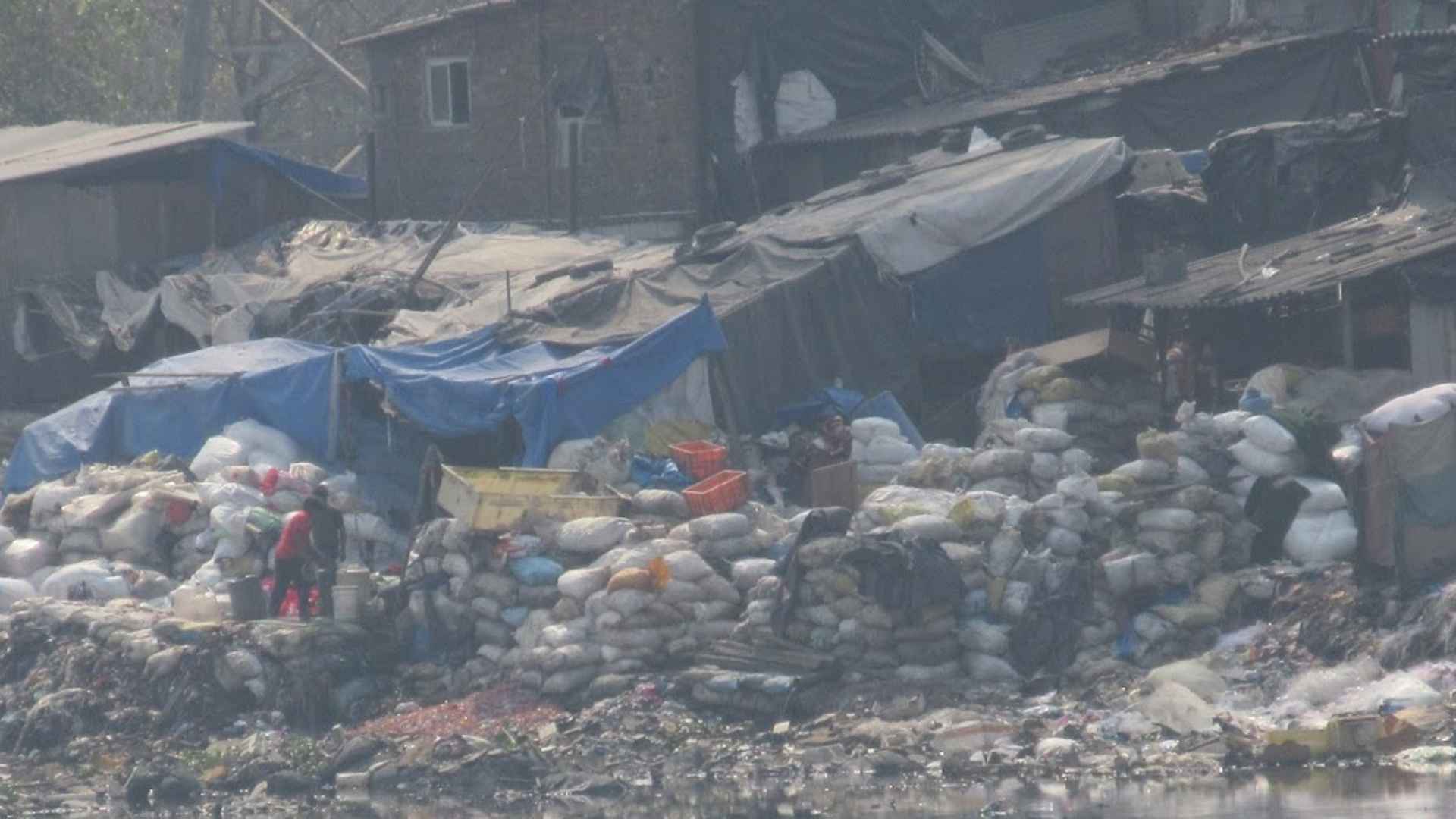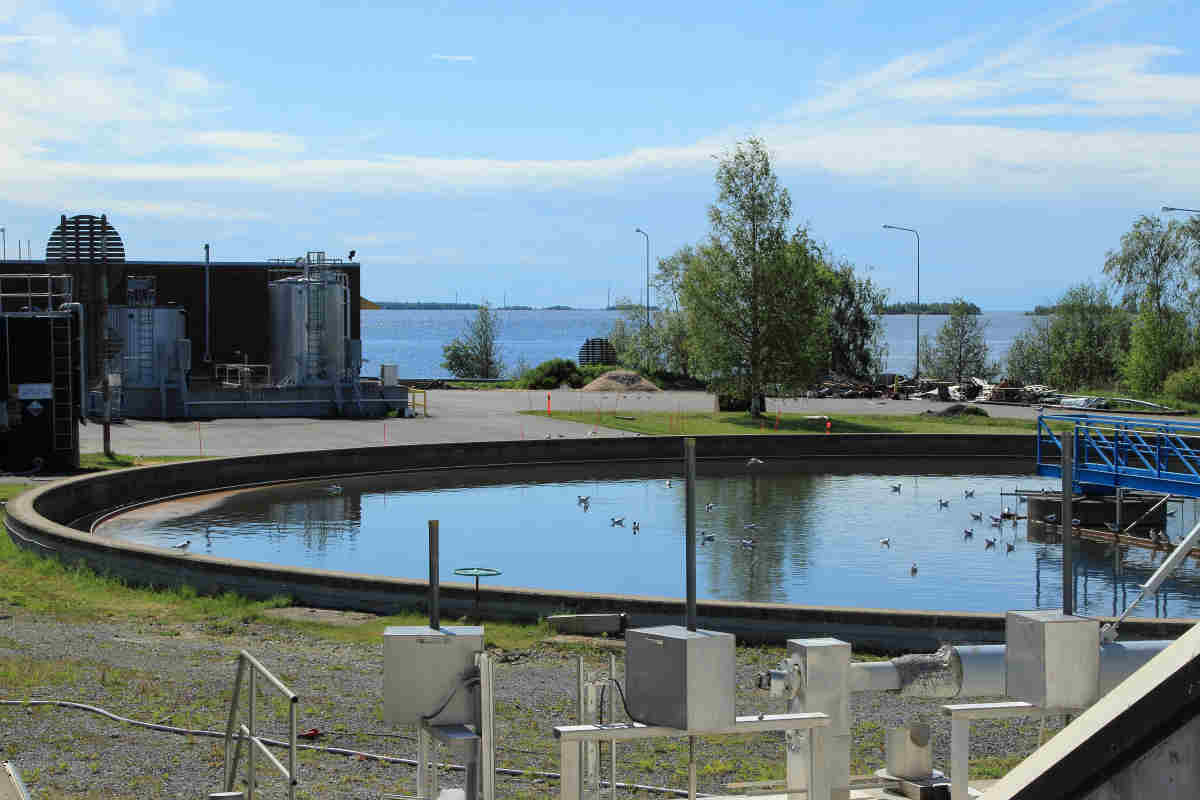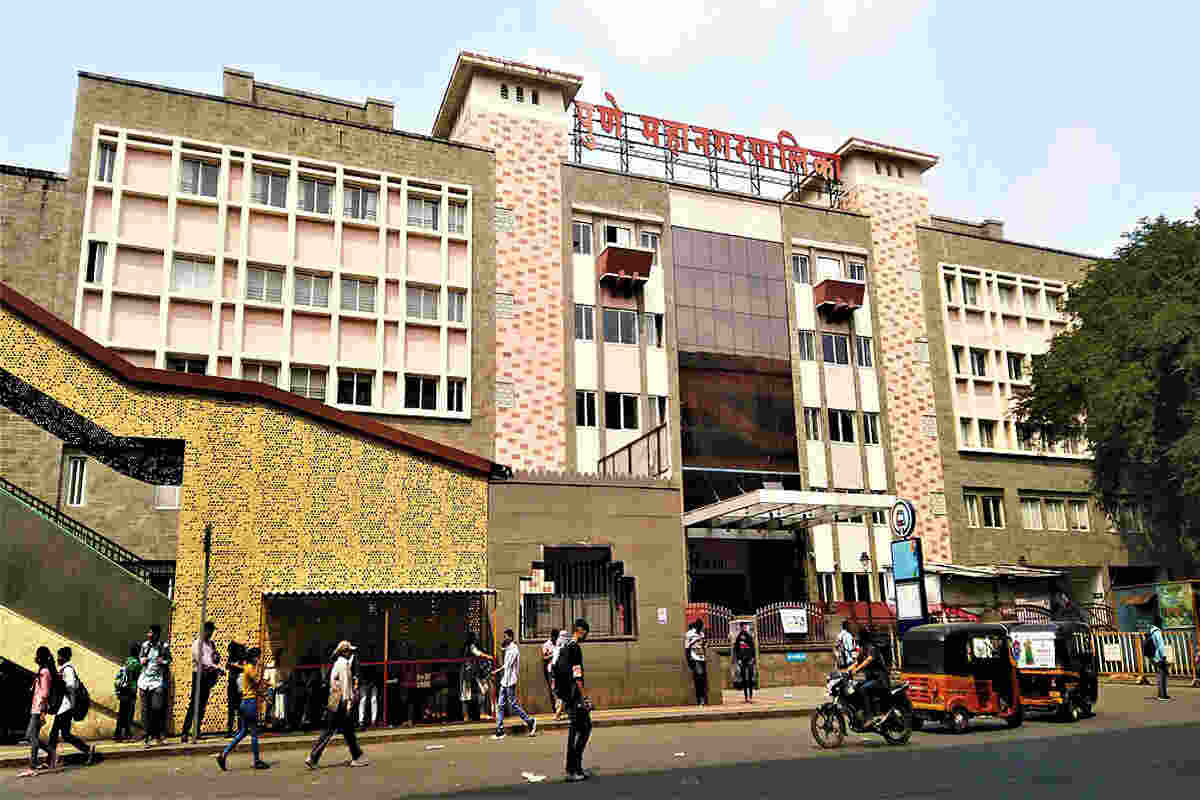Rethinking Plastic Waste: A Community-Driven Solution for Urban Pollution
Plastic pollution is one of the most pressing environmental challenges of the 21st century, with its impact rippling across ecosystems, economies, and public health. Every year, the world produces over 400 million metric tons of plastic waste, a significant portion of which is not recycled or managed efficiently.
According to a 2022 UNEP report, only 9% of all plastic ever produced has been recycled, while 79% accumulates in landfills, water bodies, and urban environments. The sheer volume of mismanaged plastic waste has transformed cities into dumping grounds, clogged drainage systems, and polluted vital water sources, exacerbating an already dire situation.
The urgency to tackle plastic waste in these areas requires scalable recovery solutions—models that can adapt to local conditions, involve communities, and create economic opportunities. Traditional top-down waste management strategies, such as large-scale recycling plants, often fail in slums due to logistical and financial constraints.
Earth5R’s Scalable Plastic Recovery Model is a unique, grassroots initiative that transforms plastic waste into a resource while engaging local communities in the process. Unlike conventional recycling systems that depend on centralized waste processing units, Earth5R’s model is built around micro-recycling units, community-driven waste segregation, and circular economy principles.
The Challenge of Plastic Waste in Slums and High-Density Areas
In the world’s rapidly growing urban centers, plastic waste has become an inescapable crisis, particularly in slums and high-density areas where waste management infrastructure is often inadequate. According to a 2022 World Bank report, urban areas generate over 2.01 billion metric tons of solid waste annually, with plastic making up approximately 12% of this total.
One of the most alarming consequences of plastic waste accumulation in slums is its impact on drainage systems. Studies conducted in cities like Mumbai, Lagos, and Jakarta have found that plastic waste is a primary contributor to urban flooding, as it clogs stormwater drains and disrupts the natural flow of water. The floods that followed heavy rains in Mumbai in 2005 and Jakarta in 2020 were exacerbated by plastic-filled drainage systems, leaving thousands homeless and causing millions of dollars in damage.
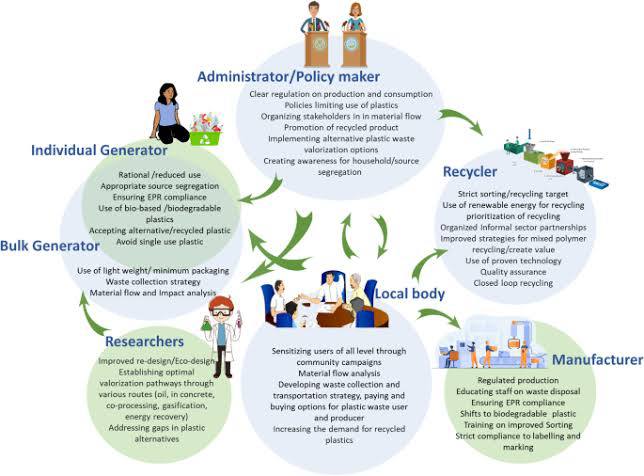
The image illustrates the roles of different stakeholders, including policymakers, manufacturers, recyclers, and researchers, in managing plastic waste efficiently.
Beyond infrastructure damage, plastic pollution also presents a major health hazard in slum communities. Burning plastic waste—a common practice in areas lacking formal disposal options—releases toxic pollutants such as dioxins and furans, which are linked to respiratory diseases, cancers, and developmental disorders in children.
Despite these hazards, formal waste management systems have largely failed to address plastic pollution in slums. Traditional waste collection services, which rely on large-scale infrastructure such as centralized landfills and recycling plants, are often inaccessible to informal settlements.
Understanding Earth5R’s Scalable Plastic Recovery Model
In the fight against plastic pollution, large-scale solutions have often failed to address the realities of urban slums and high-density areas. Traditional recycling systems, which depend on centralized collection and industrial processing, struggle to penetrate informal settlements where infrastructure is weak and waste generation is high.
Unlike conventional waste recovery models that rely on municipal services and large recycling plants, Earth5R’s approach is deeply embedded in local communities, making it more adaptable, cost-effective, and efficient. The model is based on a few key principles: community-driven waste management, a circular economy approach, and decentralized waste collection through micro-recycling units.
At the heart of this model is community-driven waste management. In most urban slums, waste collection is erratic, and formal services often bypass these areas entirely. Instead of attempting to impose a one-size-fits-all solution, Earth5R works within existing social structures, training and equipping informal waste pickers, local businesses, and residents to take ownership of their waste. By involving the very people who experience the consequences of plastic pollution firsthand, the model creates a sense of responsibility and participation.
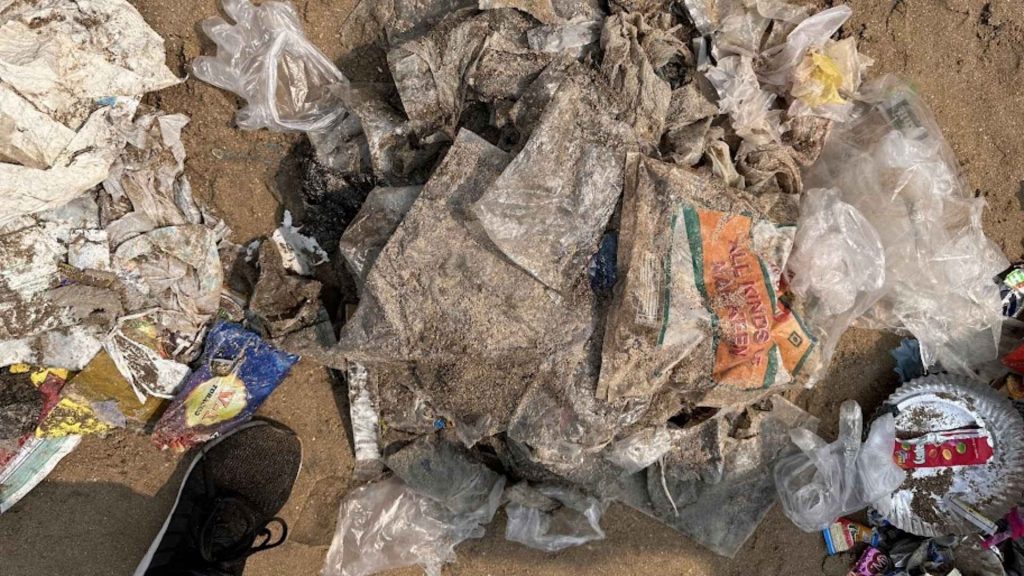
Studies on behavioral economics in waste management suggest that when individuals have a direct role in managing waste, compliance and efficiency improve significantly. In Dharavi, for example, Earth5R has established local waste hubs where trained community members segregate and process plastic waste, ensuring that recyclables do not end up in landfills or water bodies.
Another pillar of the model is its circular economy approach, which seeks to eliminate waste entirely by treating plastic as a resource rather than a problem. Instead of simply collecting and discarding waste, Earth5R ensures that recovered plastic is transformed into new materials, products, or energy sources.
Research from the Ellen MacArthur Foundation shows that circular economy initiatives can reduce plastic leakage into the environment by over 80%, while also creating new employment opportunities. Earth5R’s projects include upcycling plastic waste into eco-bricks, fabric, and consumer goods, ensuring that value is extracted at every stage of the waste cycle. This not only reduces pollution but also provides a sustainable source of income for local waste collectors and artisans.
Scientific Evidence Supporting Plastic Recovery Models
The growing plastic waste crisis has led to a surge in research-backed solutions aimed at managing and repurposing plastic more efficiently. While traditional waste management systems struggle to keep up with rising urbanization and consumption patterns, scientific studies and real-world case studies have shown that decentralized, community-led plastic recovery models can be significantly more effective.
The impact of plastic recovery on sustainability and employment is another critical area of research. A 2020 report by the International Labour Organization (ILO) found that informal waste recycling already employs over 15 million people worldwide, many of whom live in urban slums with no access to formal employment. In cities like Lagos, Nigeria, community-based plastic recovery initiatives have not only reduced pollution but also provided stable incomes to thousands of waste pickers.
In fact, research by the United Nations Environment Programme (UNEP) indicates that for every 10,000 tons of plastic waste recovered, nearly 100 new jobs are created in collection, sorting, and processing. This aligns with Earth5R’s approach, which integrates employment opportunities into plastic waste management, making it a socially and economically viable solution rather than just an environmental intervention.
Similarly, research from the London School of Economics (LSE) suggests that people are more likely to participate in waste recovery if they perceive it as beneficial to their immediate community rather than a distant, abstract environmental concern. Earth5R’s model capitalizes on this principle by empowering communities through education and direct involvement, ensuring long-term participation and sustainability.
Impact Assessment and Measurable Outcomes
One of the most notable examples of Earth5R’s impact can be seen in Dharavi, Mumbai, an area often referred to as the world’s largest recycling hub. With an estimated one million residents crammed into just 2.1 square kilometers, Dharavi generates thousands of tons of plastic waste every month. Before Earth5R’s intervention, much of this waste either clogged local waterways or ended up in informal landfills, polluting the environment and creating severe health hazards.
Beyond Dharavi, similar success stories have emerged in other high-density urban areas. In Bengaluru, Earth5R partnered with local apartment complexes and slum communities to establish a segregated waste collection system, reducing mixed waste disposal by nearly 50%. Studies conducted by the Indian Institute of Science (IISc) confirmed that decentralized recycling efforts like these have a direct correlation with increased recycling rates and reduced landfill dependency.
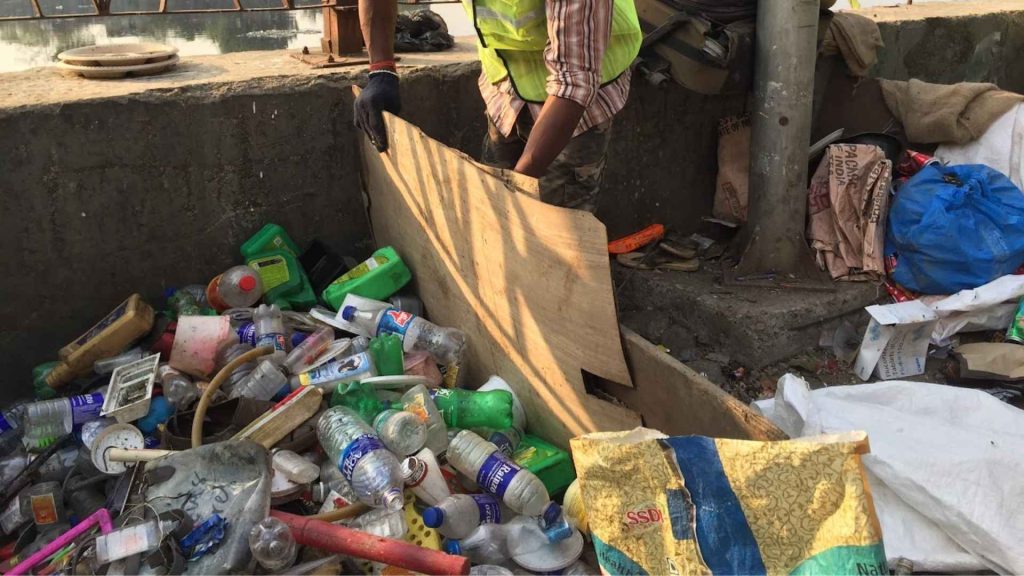
The economic benefits of plastic recovery are often underestimated, but Earth5R’s approach demonstrates that waste is not just a problem—it is an untapped resource. By partnering with manufacturers and businesses to create a circular economy, Earth5R has helped local entrepreneurs develop products made from recycled plastic, ranging from eco-bricks to sustainable packaging materials. According to a study by the United Nations Industrial Development Organization (UNIDO), cities that embrace community-based recycling models see a direct boost in local economies, with every $1 invested in waste recovery generating nearly $4 in economic value.
Implementing Earth5R’s Model: A Step-by-Step Approach to Plastic Recovery
Community Awareness and Education
No waste management system can succeed without grassroots engagement and public awareness. One of the primary reasons plastic pollution persists in slums is the lack of awareness about waste segregation, recycling processes, and the dangers of plastic accumulation. Many residents, already struggling with economic hardships, prioritize daily survival over long-term environmental concerns.
Earth5R addresses this challenge by conducting extensive educational campaigns, engaging with local schools, community leaders, and waste pickers to explain the environmental and economic value of plastic waste recovery. In Mumbai’s Dharavi slum, for instance, Earth5R’s outreach programs have taught thousands of households to separate plastic from organic waste, significantly improving the quality of materials available for recycling.
Setting Up Localized Waste Collection Systems
Once awareness is established, the next step is creating an efficient waste collection network that aligns with the infrastructure constraints of informal settlements. Unlike well-planned urban areas with designated waste disposal sites, slums often lack formal garbage collection services, forcing residents to dump waste in open spaces or waterways.
To counter this, Earth5R sets up decentralized collection points within the community, where residents can drop off segregated plastic waste. In some cases, the model leverages local waste pickers, equipping them with the tools and training needed to collect and sort plastic more effectively. Studies have shown that when communities have accessible collection systems, recycling rates increase dramatically.
Micro-Recycling Units and Processing Facilities
Traditional large-scale recycling plants require significant capital investment, advanced infrastructure, and centralized logistics networks, making them unviable for slum areas. Instead of depending on these systems, Earth5R establishes micro-recycling units—small, decentralized facilities where plastic waste is processed within the community itself.
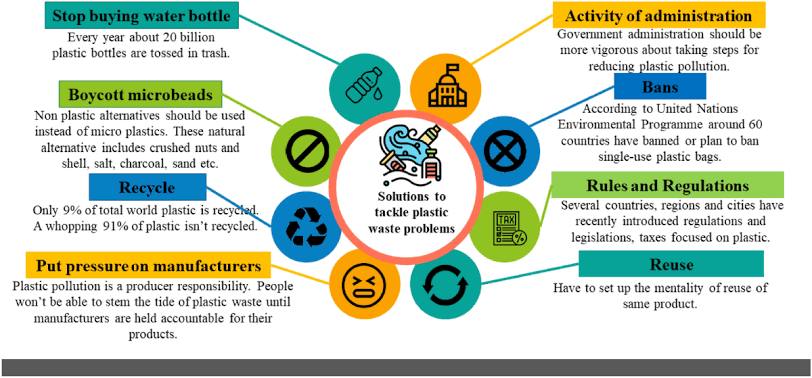
The image presents various solutions to tackle plastic waste problems, such as recycling, banning microplastics, enforcing regulations, and promoting reuse.
These units focus on sorting, shredding, and repurposing plastic waste into reusable products, such as eco-bricks, recycled plastic sheets, or raw materials for local businesses. The success of this approach is evident in cities like Manila and Bogotá, where similar micro-recycling hubs have generated employment while significantly reducing plastic waste.
Integration with Businesses and Local Economies
For any plastic recovery model to be financially sustainable, it must be integrated into the local economy. A major challenge in waste management is the disconnect between waste generators, waste processors, and businesses that could use recycled materials. Earth5R bridges this gap by partnering with local businesses, artisans, and manufacturers who can repurpose processed plastic into marketable products.
For instance, in Dharavi’s thriving informal economy, recycled plastic is converted into wallets, bags, and household items, creating employment opportunities for waste pickers and small-scale manufacturers. Research shows that recycled plastic-based industries can reduce production costs by 30-40% compared to virgin plastic, making them an attractive business proposition.
Scaling the Model for Other Urban Areas
Scaling begins with identifying new areas that can benefit from the model, conducting community assessments, and tailoring the system based on the specific challenges of each settlement. In some cities, digital tracking tools are integrated to monitor plastic collection rates, allowing real-time adjustments to improve efficiency. Partnerships with municipal bodies and NGOs help in expanding the reach of micro-recycling units, while corporate social responsibility (CSR) funding plays a critical role in covering initial setup costs.
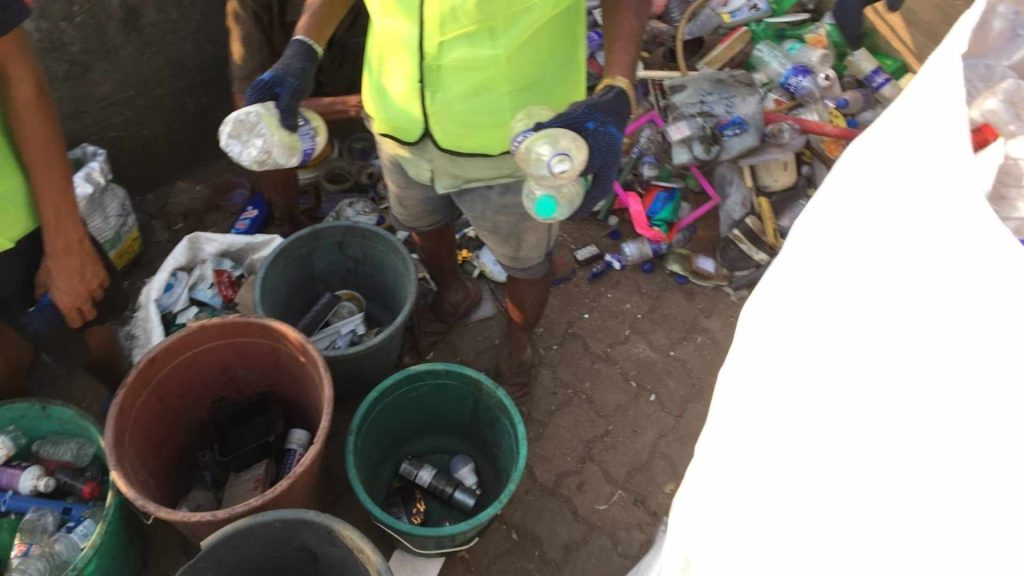
The model has already shown promising results in multiple cities across India, and its potential extends to urban slums in Africa, Southeast Asia, and Latin America. With proper funding, government backing, and community engagement, Earth5R’s Scalable Plastic Recovery Model can redefine urban waste management, transforming plastic waste from an environmental threat into a sustainable economic opportunity.
Case studies from Earth5R : Real life impact
Earth5R has documented its initiatives and models for scalable plastic recovery in slums and high-density areas through several insightful articles on their website. Below are some notable examples:
Earth5R Conducts Community Training in Slum Areas of Mumbai
This article details Earth5R’s efforts in Mumbai’s slum areas, such as Kurla, Vikhroli, Powai, and Andheri, where the organization has provided training on waste management, composting, and livelihood generation. The initiative focuses on educating residents about waste segregation and creating products from discarded materials to generate income, thereby promoting a circular economy and improving local waste management practices.
Earth5R’s Step-by-Step Plastic Cleanup Framework for Community Engagement
This comprehensive guide outlines a structured approach to organizing sustainable plastic cleanup drives. It emphasizes the importance of research and planning, community mobilization, and effective execution. The framework is designed to be replicable in various communities, aiming to restore ecosystems, reduce microplastic contamination, and promote biodiversity.
Earth5R’s Mithi River Community Cleanup Model
Focusing on the Mithi River in Mumbai, this article describes Earth5R’s model for community-driven river cleanup. The approach includes drone mapping for waste hotspot identification, community engagement, and the establishment of stewardship programs. The initiative not only addresses environmental restoration but also provides sustainable employment opportunities for local residents.
A New Approach to Restoration of Mithi River, India
This piece discusses Earth5R’s collaborative project aimed at cleaning the Mithi River using innovative tools and promoting a circular economy. The project involves waste management training for residents, slum dwellers, and industries along the river’s catchment area, emphasizing the importance of community involvement in sustainable restoration efforts.
Revolutionizing Pune City Through a Circular Economy
Highlighting Earth5R’s initiatives in Pune, this article explores efforts to promote a circular economy by conducting art workshops using recycled office waste and providing environmental education to slum communities. The programs aim to raise awareness and encourage sustainable practices among residents, contributing to effective waste management and environmental conservation.
Nairobi River Pollution: Scope for the Future
While focusing on Nairobi, this article references Earth5R’s sustainable livelihood programs in Mumbai slums as exemplary models. It discusses the potential for implementing similar circular economy solutions to address river pollution and improve the livelihoods of communities residing along riverbanks.
These articles provide valuable insights into Earth5R’s scalable plastic recovery models and their implementation in various urban settings, emphasizing community engagement, circular economy principles, and sustainable development.
Challenges and the Road Ahead
Financial and infrastructural limitations further complicate efforts to scale and sustain plastic recovery operations. While community-driven recycling is cost-effective, establishing micro-recycling units and training waste pickers require initial investments that are often difficult to secure. Many slum settlements lack basic waste segregation facilities, forcing recyclers to work under hazardous conditions.
In cities like Jakarta and Nairobi, where informal recycling networks handle a significant portion of waste, researchers from the World Bank have observed that a lack of funding for proper sorting facilities leads to inefficiencies and contamination of recyclable materials. Without greater investment in localized infrastructure, the full potential of decentralized waste recovery remains unrealized.
Scalability is another challenge that must be tackled. While Earth5R’s model has demonstrated success in high-density urban areas, replicating it in diverse geographical and socio-economic contexts presents new obstacles. Cultural attitudes toward waste, economic conditions, and existing municipal policies vary widely across cities and countries, requiring tailored approaches for each new location.
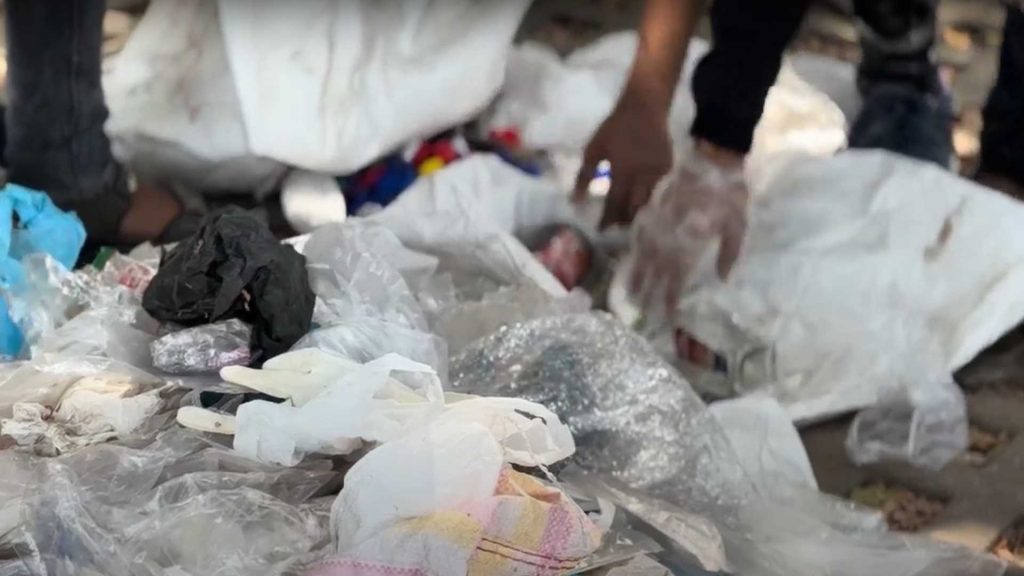
For example, while community engagement has driven recycling success in Mumbai’s Dharavi, similar efforts in cities like São Paulo and Manila have faced resistance due to deep-rooted social stigmas associated with waste collection. The challenge lies in adapting the model while maintaining its core principles of decentralization, circular economy, and community participation.
The road ahead is challenging, but not insurmountable. With greater collaboration between policymakers, businesses, and environmental organizations, scalable plastic recovery can become a global reality. Initiatives like Earth5R are proving that waste is not just an environmental crisis—it is an opportunity for innovation, economic development, and social transformation.
Empowering Communities for a Plastic-Free Future: A Collective Responsibility
The plastic pollution crisis in urban slums and high-density areas is not just an environmental issue—it is a social, economic, and public health challenge that demands urgent action. As the evidence has shown, Earth5R’s Scalable Plastic Recovery Model provides a practical, community-driven solution that addresses multiple facets of the problem.
Through decentralized waste collection, micro-recycling units, and a circular economy approach, this model has significantly improved plastic recovery rates, created employment opportunities, and fostered environmental awareness in some of the world’s most vulnerable communities. Case studies from Mumbai, Bengaluru, and beyond confirm that when local communities are empowered, waste management becomes more efficient, cost-effective, and sustainable.
However, the fight against plastic pollution cannot be won by one organization alone. Multi-stakeholder collaboration is essential to ensure the long-term success of scalable plastic recovery models. Governments must enact policies that support decentralized recycling systems, recognizing informal waste pickers as essential contributors to urban waste management.
FAQs on Earth5R’s Scalable Plastic Recovery Model for Slums and High-Density Areas
What is Earth5R’s Scalable Plastic Recovery Model?
Earth5R’s model is a community-driven waste management system that focuses on decentralized plastic recovery, micro-recycling units, and a circular economy approach. It is designed to work in slums and high-density areas where traditional waste management systems are inefficient or absent.
How does this model differ from conventional waste management?
Unlike conventional municipal waste systems that rely on centralized landfills, Earth5R’s model empowers local communities to collect, sort, and recycle plastic waste at the source. This minimizes transportation costs, reduces landfill dependency, and creates economic opportunities for waste pickers.
Why is plastic pollution a major issue in slums and high-density areas?
Slums and high-density urban regions often lack proper waste management infrastructure, leading to plastic waste accumulating in streets, drains, and water bodies. This contributes to severe environmental pollution, health hazards, and flooding during monsoons.
What are micro-recycling units, and how do they work?
Micro-recycling units are small, localized facilities that process plastic waste collected from communities. They use low-cost, scalable technology to convert waste into reusable products such as eco-bricks, packaging materials, or recycled pellets for manufacturing.
How does this model benefit waste pickers and informal recyclers?
Earth5R integrates waste pickers into a formalized recycling system, providing them with better wages, training, and safer working conditions. This reduces exploitation and ensures that their contribution to waste management is recognized and rewarded.
What is the role of the circular economy in this model? The model follows circular economy principles, where plastic waste is not discarded but repurposed into valuable products. By creating a closed-loop system, it reduces the demand for virgin plastic and encourages sustainable production practices.
How successful has Earth5R’s model been so far?
Earth5R has successfully diverted thousands of metric tons of plastic waste from landfills, improved local waste management, and generated sustainable employment in cities like Mumbai, Bengaluru, and Chennai. Studies indicate a 40% increase in recycling efficiency in areas where the model is implemented.
What challenges does the model face?
Key challenges include policy barriers, lack of government support, funding constraints, and resistance to behavioral change. Many cities still lack proper waste segregation policies, making it difficult to scale and integrate decentralized recycling systems.
Can this model be replicated in other cities or countries?
Yes, the model is highly adaptable and can be replicated in different urban environments, provided there is community participation, policy support, and basic infrastructure for waste collection and sorting.
What role do local governments play in supporting this model?
Local governments can support the initiative by recognizing decentralized waste management, providing funding for micro-recycling units, enforcing plastic waste regulations, and incentivizing businesses to adopt circular economy practices.
Are there any case studies that prove the model’s effectiveness?
Yes, case studies from Dharavi, Mumbai, show that plastic recovery increased by 67% after implementing this model. Similarly, in Chennai, clearing plastic-clogged waterways through community waste recovery significantly reduced urban flooding risks.
What scientific evidence supports decentralized plastic recovery?
Research from institutions like the Indian Institute of Science (IISc) and the Ellen MacArthur Foundation confirms that decentralized plastic recovery reduces landfill waste, lowers carbon emissions, and improves resource efficiency compared to centralized waste systems.
How does plastic recovery impact the local economy?
Plastic recovery creates sustainable job opportunities, reduces waste disposal costs, and enables local businesses to use recycled materials, generating new economic avenues. Every $1 invested in community recycling can yield up to $4 in economic benefits, according to UNIDO studies.
How does behavioral change contribute to the success of this model?
Public participation is key. Education and awareness campaigns encourage households to segregate waste, reduce plastic usage, and participate in local recycling efforts. Community engagement ensures that waste recovery is consistent and effective.
What types of plastic waste can be recovered using this model?
The model can recover a wide range of plastics, including PET bottles, plastic packaging, single-use plastics, and hard plastics. Some low-value plastics can also be repurposed into alternative building materials like eco-bricks.
How can businesses and corporations support Earth5R’s model?
Corporations can fund micro-recycling units, invest in plastic waste recovery programs, and shift towards using recycled plastic in their products. By adopting circular economy strategies, businesses can reduce their environmental impact.
What technological innovations are being explored for better plastic recovery?
AI-driven waste sorting, biodegradable plastic alternatives, and advanced plastic-to-fuel conversion technologies are some innovations being researched to enhance plastic recovery efficiency.
How can individuals contribute to this initiative?
Individuals can support the model by segregating their household waste, reducing plastic consumption, participating in community recycling programs, and spreading awareness about sustainable waste management.
What is the long-term vision of Earth5R’s plastic recovery initiative?
The goal is to create self-sustaining waste recovery ecosystems in urban areas worldwide, where plastic waste is not seen as garbage but as a resource that fuels economic growth, environmental sustainability, and social development.
What policy changes are needed to make this model more effective?
Governments should enforce mandatory waste segregation, provide financial incentives for community recycling initiatives, ban single-use plastics, and integrate informal waste pickers into the formal waste management system to make decentralized plastic recovery more impactful.
Take Action: Be a Part of the Solution
The fight against plastic pollution in slums and high-density areas requires collective action from individuals, businesses, and policymakers. Earth5R’s Scalable Plastic Recovery Model has already demonstrated its impact, but to expand and sustain these efforts, your involvement is crucial.
Start by segregating your waste, reducing plastic usage, and supporting local recycling initiatives. Volunteer for cleanup drives, educate your community, and advocate for responsible waste management practices. Every small action contributes to a larger change.Adopt sustainable packaging, invest in recycled materials, and support community-driven plastic recovery initiatives. Collaborate with organizations like Earth5R to implement circular economy solutions that benefit both the environment and society.
Implement policies that recognize informal waste workers, promote decentralized recycling infrastructure, and encourage Extended Producer Responsibility (EPR) programs. Legislative backing can accelerate the transition to a zero-waste economy.Whether through volunteering, funding, corporate partnerships, or policy advocacy, you can help scale this model to more cities and communities worldwide. Together, we can transform plastic waste from an environmental crisis into an opportunity for sustainability, economic growth, and social empowerment.
– Authored by Mridu Mishra

